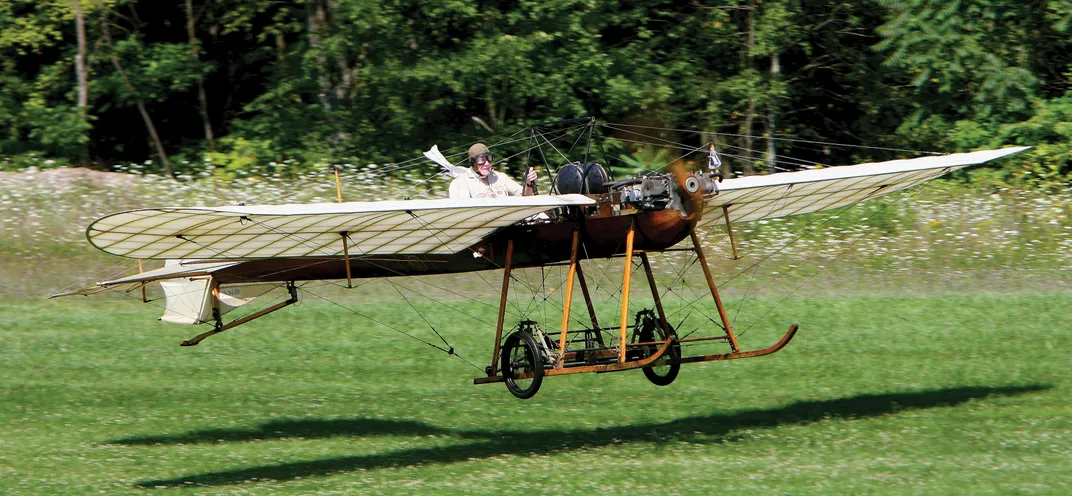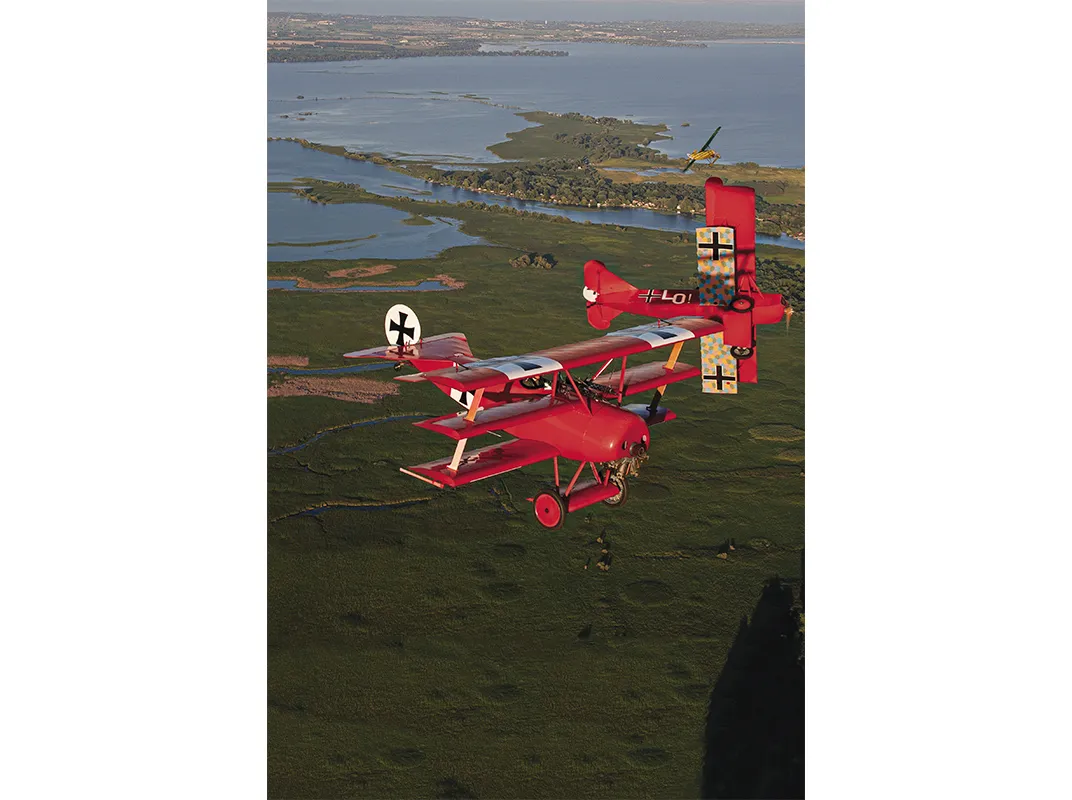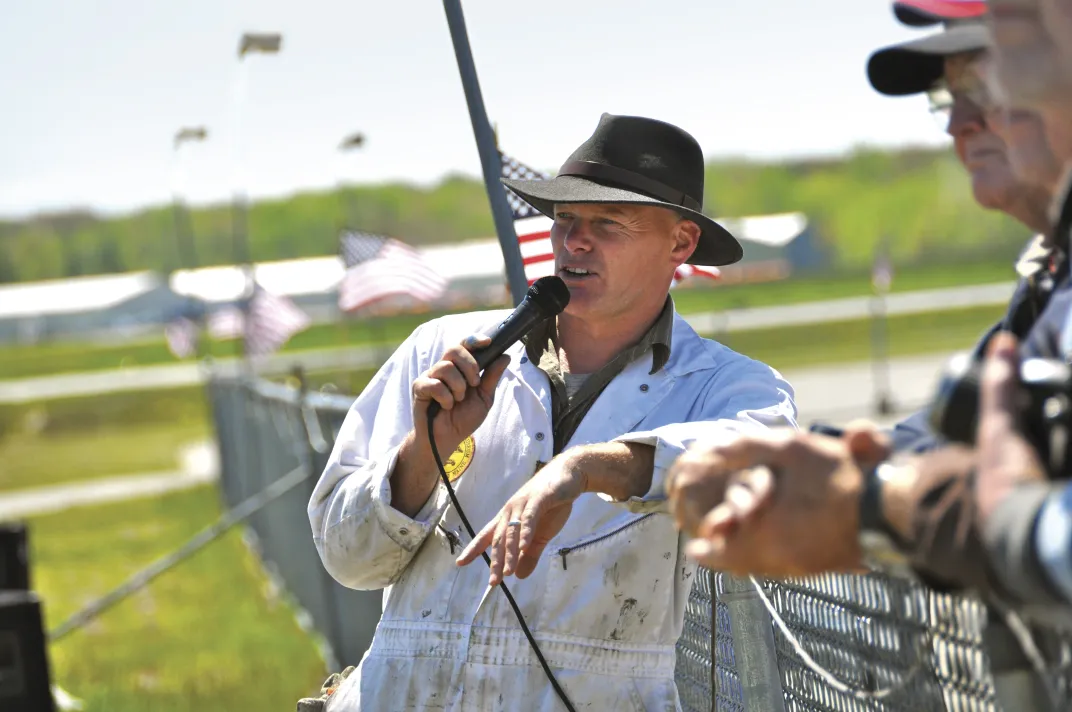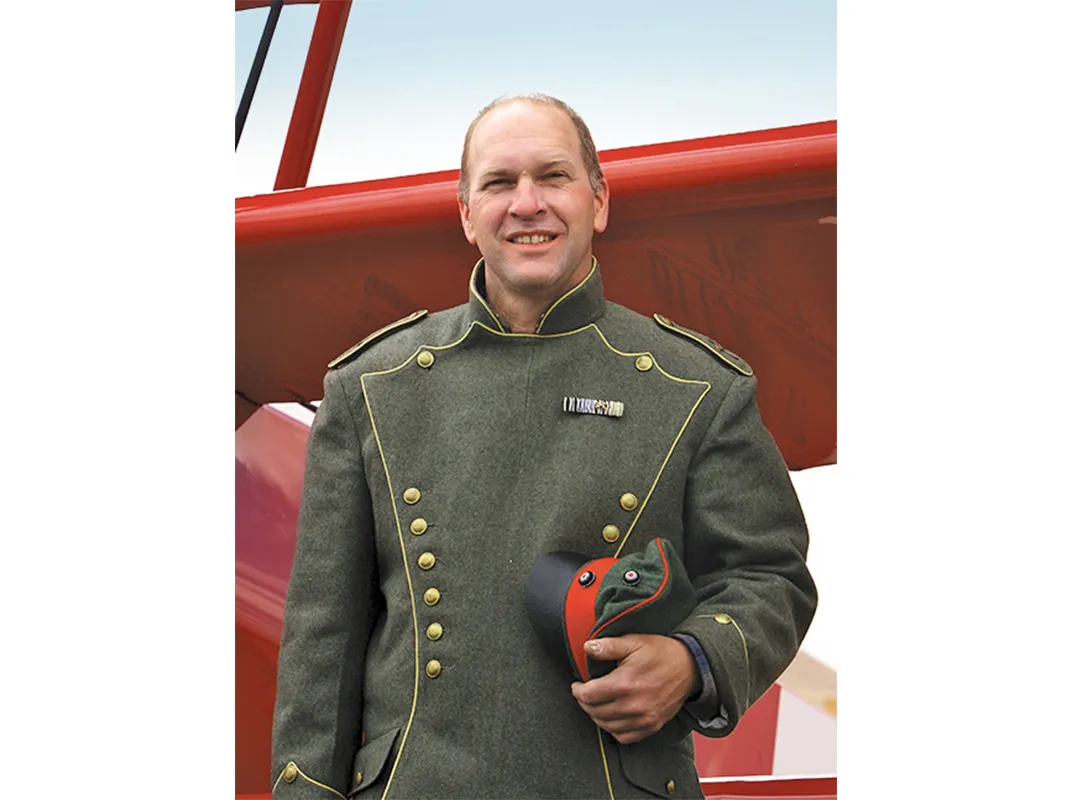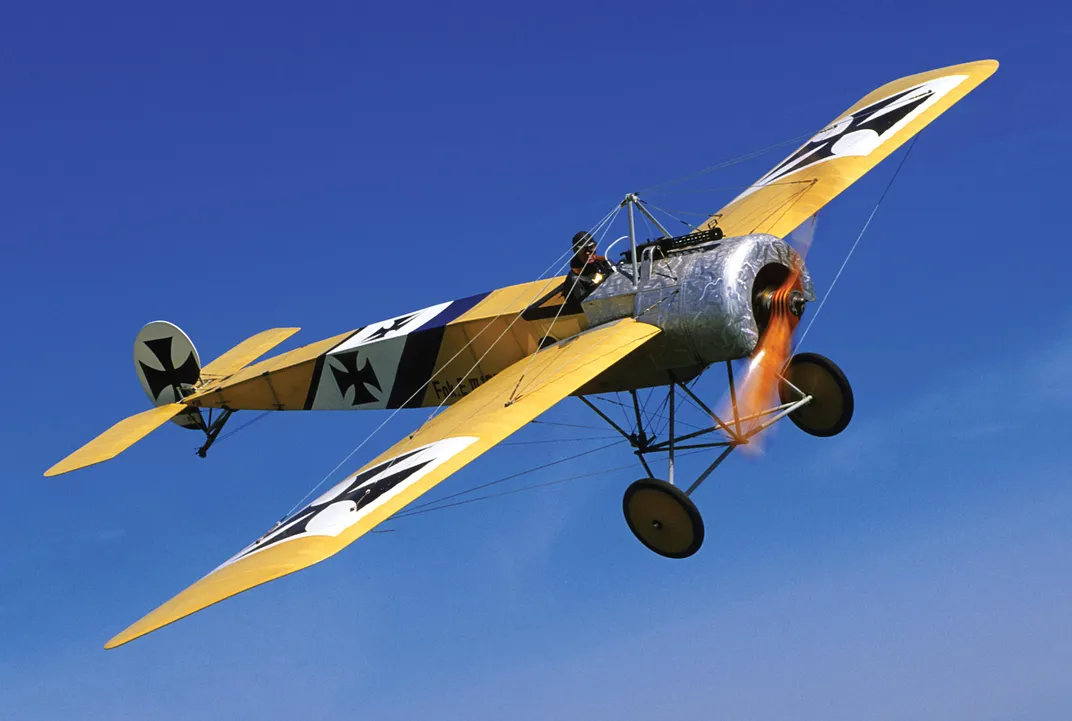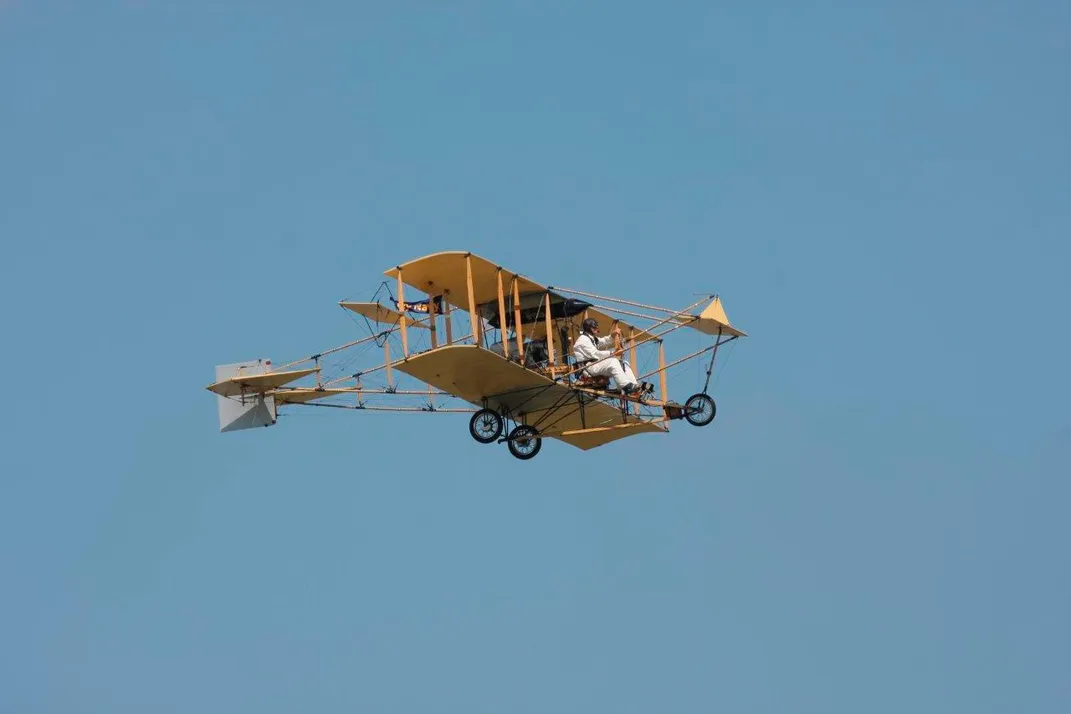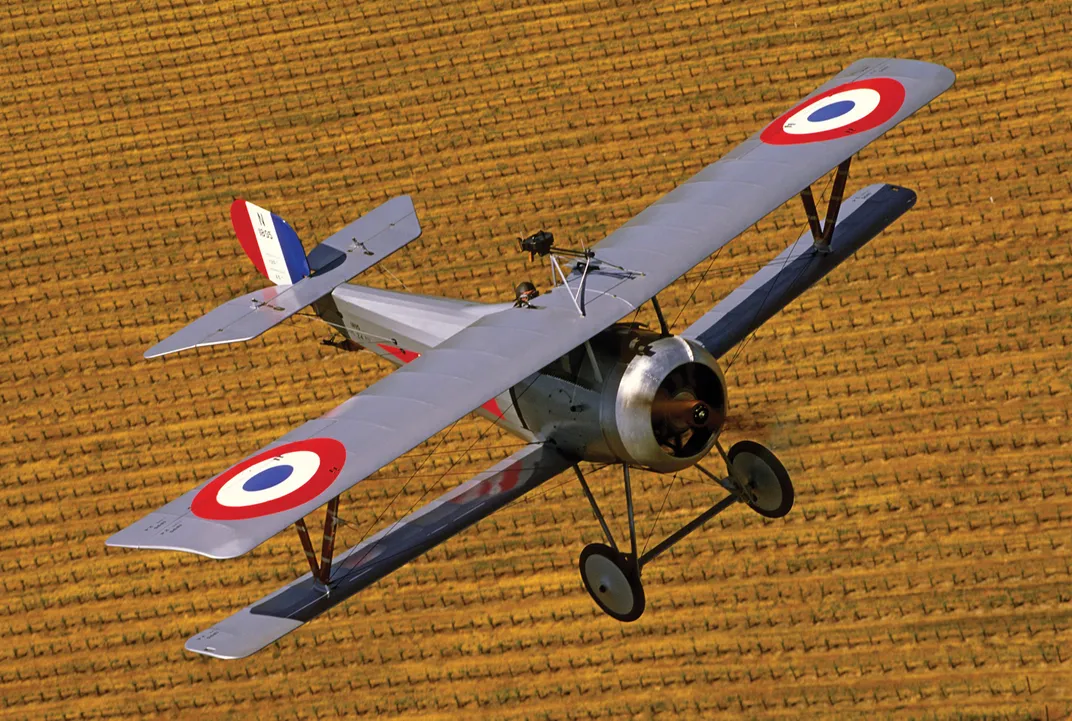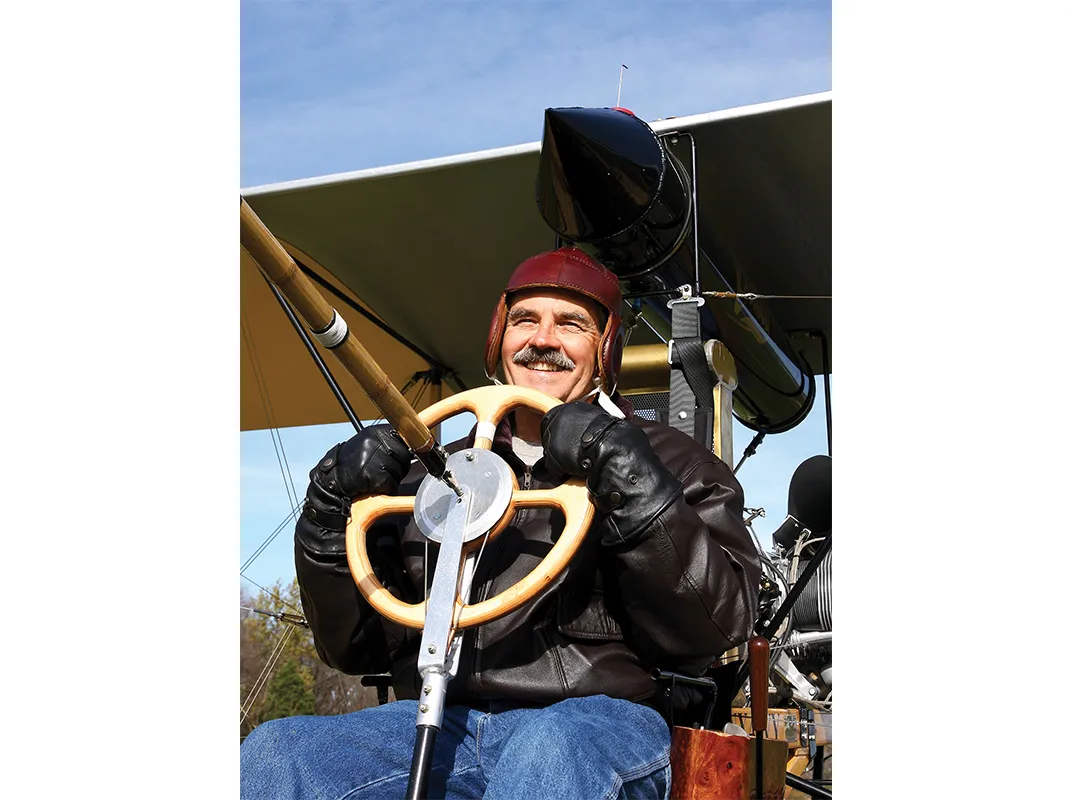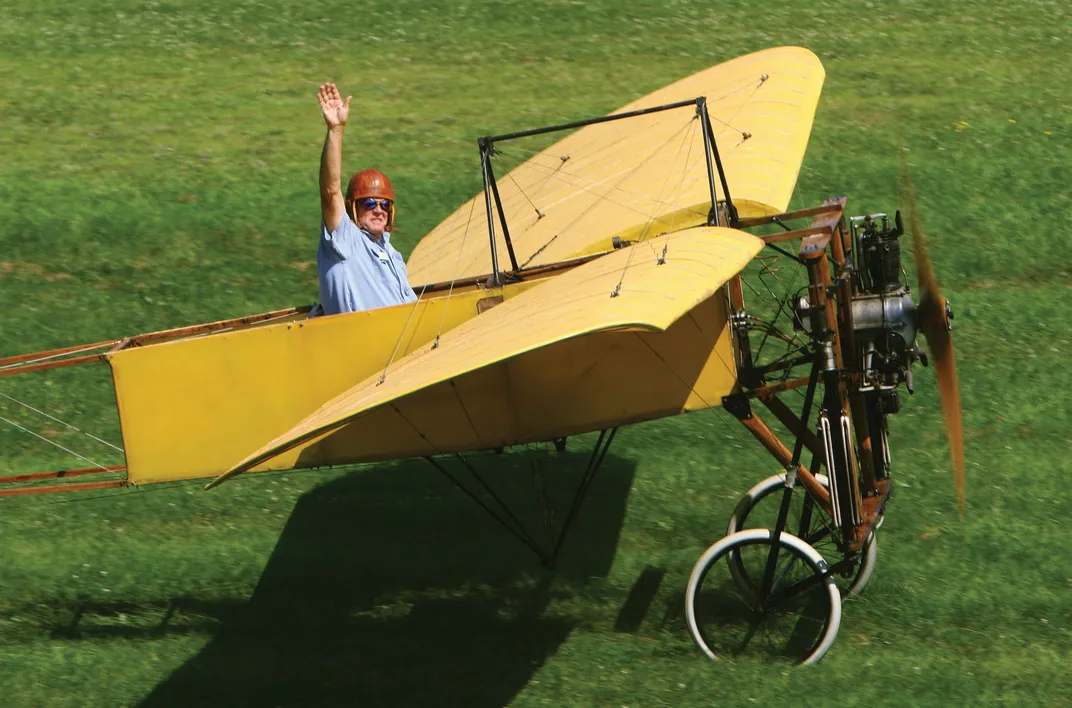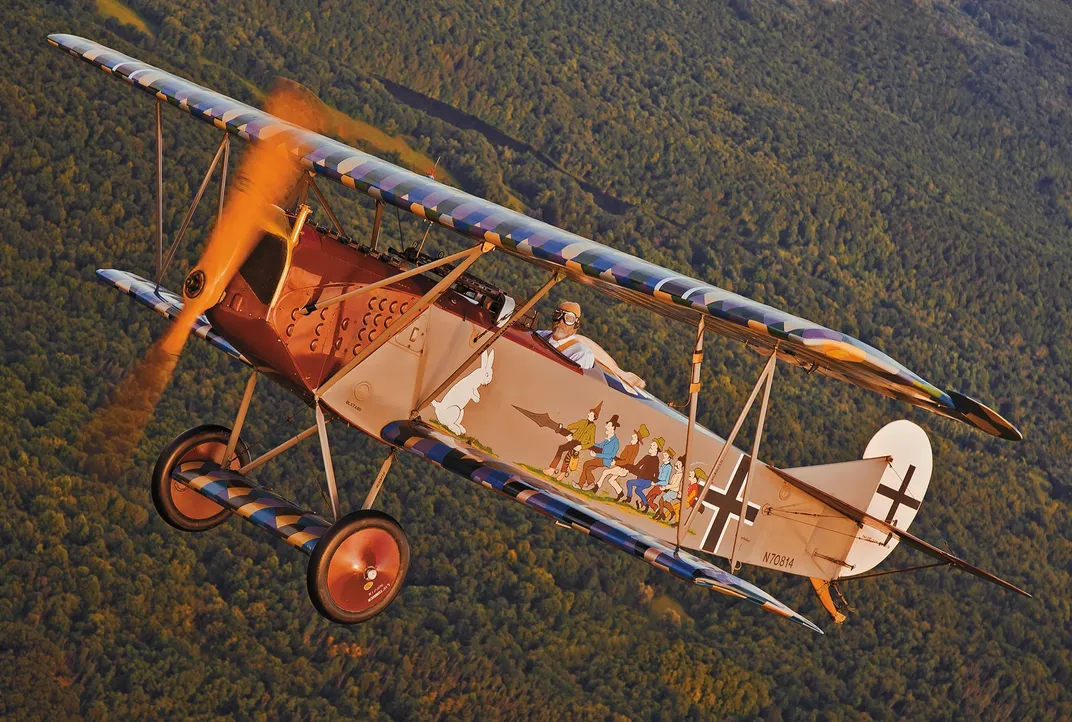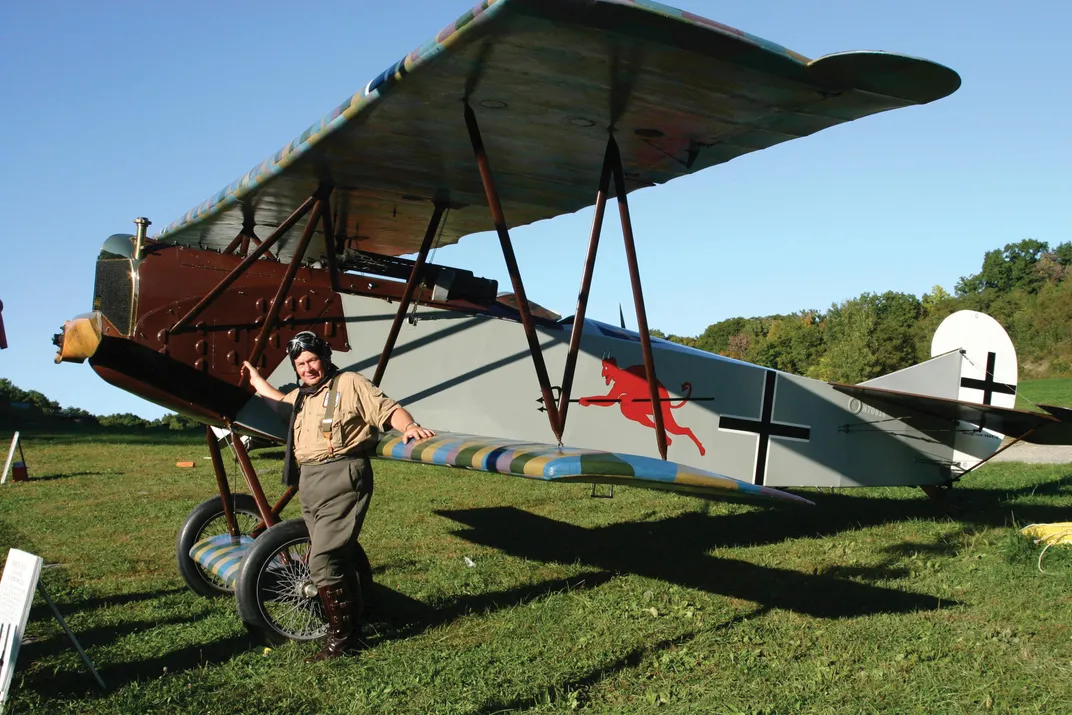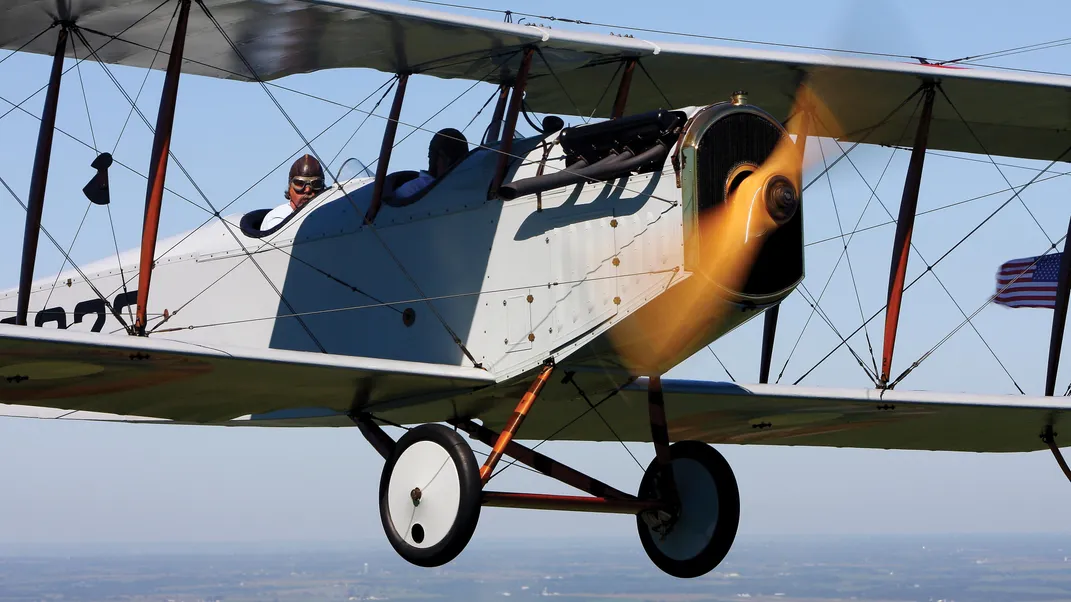Ten Antique Airplanes and the Pilots Who Dare to Fly Them
The dangers and demands of piloting vintage aircraft.
:focal(530x265:531x266)/https://tf-cmsv2-smithsonianmag-media.s3.amazonaws.com/filer/79/7d/797d6ed1-d566-4145-8a2b-7fe93d9ca154/10k_am2016_dantaylor2_live-resize2.jpg)
Nearly every airplane flying today, from a humble Cessna to the mammoth Airbus A380, uses the same stick-and-rudder-style controls. Moving the yoke or stick back and forth changes pitch; moving it sideways controls roll; pushing rudder pedals adjusts yaw. Airplanes great and small have almost the same feel, and until acted upon by some outside force, most will fly straight and level. That hasn’t always been the case.
A few years ago, near Kitty Hawk, North Carolina, I learned to fly an exact reproduction of the Wright brothers’ 1902 glider, the first aircraft that offered complete control over yaw, pitch, and roll. But there was no stick: A horizontal cross-member linked to the forward-mounted elevator controlled pitch. By rotating the cross-member with both hands, the pilot could move the elevator up or down. To control roll, the pilot shifted his hips on the cradle he was laying on. Activating the cradle twisted the wings (“wing warping,” the brothers called it), and in no time they were turning like crazy. As for yaw, the rudder, which was wired to the cradle, moved in conjunction with the wings. After a few hard landings, I got the hang of it and logged a few five-second glides. But flying this aircraft felt difficult and nerve-racking. And I had to hold my neck up so long it hurt. I began to wonder about the pilots who routinely fly antique airplanes: Did they have similar reactions? Here’s what I learned.
Fokker Dr.I Triplane
Dutch aviation pioneer Anthony Fokker founded an airplane manufacturing company in Germany, producing such military airplanes as the renowned Dr.I, flown by German ace Manfred von Richthofen—the Red Baron.
Pilot: Mark Holliday was a pilot for the former US Airways.
“The Dr.I replica doesn’t have a rotary engine, it has a modern engine. I flew it [from Fort Lupton, Colorado] to Dayton, Ohio, and I’ve flown it to Oshkosh. It’s a lot of fun for about 15 or 20 minutes. Then after that, no. It wasn’t designed for a cross-country flight. It’s not bad in smooth air, but if you get up into bumpy air, you get worn out because the tail sashays back and forth and slings you around all the time, and you have to keep pressure on both rudder pedals. It doesn’t carry enough fuel—thank goodness—so it flies only about an hour and 15 minutes. After that, you’re just grateful to land and stretch your legs.”
Curtiss Model D
Introduced in 1911, the Model D was flown by the U.S. Army Signal Corps and U.S. Navy.
Pilot: Dan Taylor restores vintage aircraft, lectures on aviation history, and works as a radio personality at WCBS-FM in New York City.
“In its day, it was a very significant airplane. It was the first type to land on a ship, and many people saw flight for the first time with Curtiss exhibitions at county fairs. Sitting on the little seat racing down the runway, you’re acutely aware of the engine roaring behind you. A little intimidating at first, and one of those things you have to be mindful of because if there’s an accident, you’re going to be first on the scene. The controls on the Curtiss Model D are borrowed from the auto and motorcycle world: a steering wheel column for rudder and pitch. The throttle is at your right foot. And like riding a bike or a motorcycle, to turn, you lean in the hinged seat from side to side. You must be careful landing. There’s no suspension, so you have to land gently. It takes very little to put the wheels through the lower wing. To me though, an absolute joy to fly.”
The 1910 Hanriot
René Hanriot founded his company in France, and his background in designing boats shows: The wood fuselage of this monoplane could pass for a crew shell.
Pilot: Karl Erickson ran the aviation department at the Owls Head Transportation Museum in Maine. He has restored numerous vintage airplanes.
“The first time I flew the Hanriot reproduction, it felt fairly normal, and the characteristics were as expected. I had learned to fly in a modern airplane but had spent very little time in them. Most of my early flying took place in vintage airplanes. An original Anzani-powered 1909 Blériot XI, which I had the pleasure of trying to fly, I believe to be the worst machine to control. The Hanriot, on the other hand, flies like a Piper Cub: controllable, light, and just delightful. But [the Hanriot] flies far slower than modern light airplanes, so you have to be on your game because the speed range between flying and stalling is extremely small.”
Fokker E.III
During World War I, the German air force put the E.III monoplane into combat operations in December 1915.
Pilot: A former racing pilot and a stunt pilot for the film industry, Chuck Wentworth restores antique airplanes.
“I’ve been flying the E.III for 20 years. The flights aren’t very long—you don’t go anywhere. I’d say your average flight is 15 minutes. It’s a fairly similar airplane to the Blériot XI: Both airplanes have a square fuselage and wing warping. The Blériot is way underpowered. The E.III’s a bigger airplane so it has a 100-horsepower engine. The airplane will go probably 90 [mph]. No way the Blériot would go that fast. The E.III has a lot of lift, but it’s also got a lot of drag. It flies very nice. It has a good climb rate, very maneuverable. But to actually roll the airplane, I’d have to climb to a thousand feet, and there’s no sense risking everything.”
Nieuport 24
It was built to replace the Nieuport 17, but in World War I, most French squadrons, plus some Allied units, went with the Société Pour L’Aviation et ses Dérivés SPAD S.VII instead. The Rand McNally Encyclopedia of Military Aircraft says the Nieuport 24’s performance as a fighter is “uninspiring,” and while many U.S. pilots trained in one, in actual combat they upgraded to a SPAD.
Pilot: Jim Record flies a North American SNJ-2 for the Geico Skytypers at airshows and is an adjunct professor at Dowling College’s School of Aviation in Long Island, New York.
“We bought the Nieuport replica as an incomplete project from a guy in California. There are no originals flying. That’s the problem with old airplanes: You can’t afford to risk flying them. The airframe setup is the same [as on the original Nieuport 24], only the [new, modern] engine is different. The old Nieuports had rotary engines. The first flight was fairly anticlimactic. We had prepared for it so long and so completely, and there were no issues. I was too busy verifying its flying characteristics to enjoy the flight. I was just glad that it flew as predicted. The -24 is kind of a handful to fly. As with most World War I fighters (except the Fokker D.VII), they do not exhibit much stability in pitch or yaw. As such, [the -24] has to be flown every second, not just trimmed up and monitored. If you divert your attention to a chart or some navigation landmark on the ground, the ship simply points or flies wherever it wants to.”
1911 Ely Curtiss Pusher
In November 1910, Eugene Ely took off from the deck of the USS Birmingham in a Curtiss Model D (see p. 21). On another flight two months later, he landed on the USS Pennsylvania. Both takeoff and landing were firsts, and both succeeded on the first try—a good omen for aircraft carriers as the future of naval aviation.
Pilot: A retired captain for Continental Airlines, Bob Coolbaugh enjoys restoring and barnstorming Golden Age airplanes.
“This airplane has almost 160 hours, and 95 hours are mine. This is a full-scale replica: The wingspan and fuselage length and material used in it match the original drawings. But changes were made for safety’s sake. You don’t want to die in an airplane you built. Unfortunately, we built the airplane too close to the original, so it flies like crap, to be honest. It’s not the airplane’s fault; it’s just the result of the state of aerodynamics in 1911.
You have to have a lot of patience with this airplane. It has marginal control stability in roll and pitch with tremendous parasitic drag. This is one of the only airplanes I have ever flown that decelerates when pointed down.
On October 8, 2010, we were sitting on the deck of the USS George H.W. Bush [the Curtiss had been hauled there with a crane to celebrate the birth of U.S. naval aviation]. I could have made a takeoff, a landing, and another takeoff, but they wouldn’t let us do it. Basically the response was ‘risk management.’ It’s the way the world is nowadays.”
1909 Blériot XI
The Blériot XI is the aircraft in which French aviator Louis Blériot made the first airplane flight across the English Channel, on July 25, 1909. (That aircraft is now on display at the Musée des Arts et Métiers in Paris.) Another Blériot XI, part of the Shuttleworth Collection in England, is the oldest airworthy airplane in the world.
Pilot: Roger “Dodge” Bailey is chief pilot of the Shuttleworth Collection of historic aircraft in Bedfordshire, England.
“The aircraft is only just capable of flight and has virtually zero excess power for climbing. This limits our flying to straights along a [2,300-foot] grass runway.
My first impression of the Blériot is that there is a need for a continuous push force on the stick for the entire flight. It’s not possible to determine whether this is due to the aircraft being out of trim or statically unstable longitudinally; probably it’s a bit of both. It’s important to understand the deficiencies of the design and work with them. One has to fly this aircraft with your head, not your heart.
I don’t think I will ever feel comfortable in our Blériot, as the performance margins are too small. Bearing in mind I don’t fly it very high—eight to 10 feet—I have not been able to explore its full flight envelope. Within the envelope I have explored, I think I now know where the difficult areas are and try to cope with them. But that is not to say I can always avoid them. Given sufficient engine power to get the airplane to a reasonably low angle of attack, the handling qualities may improve somewhat. However, we are always flying at high angle of attack, and in that regime, the Blériot is a thoroughly unpleasant aircraft. It is certainly not comfortable—not least because the pilot and his goggles are liberally doused with oil within about a minute. My guess is that [Louis] Blériot was of the ‘Let’s just get it airborne’ mindset.”
Curtiss JN-4
America entered World War I late, and to train pilots, the military bought thousands of two-place Curtiss JN-4 “Jennys.”
Pilot: Andrew King owns an airplane restoration shop in Virginia. He has logged 3,700 hours in 130 aircraft types.
“I tell people that you can teach anyone’s grandmother to fly the Jenny. In calm weather, it’s pretty stable. The controls are heavy [they require a lot of strength to move them]. It’s a high-drag airplane. The biggest rule is to not get too slow. You don’t want to stall out of a turn, so you keep the speed up. It’s a pretty amazing airplane. If you look out through the top of the cylinders, the rocker’s arms are wagging up and down, which makes a neat framework from which to look out at the world.”
Fokker D.VII
The Fokker D.VII appeared on the Western Front in May 1918, drawing respect from Allied pilots.
Pilot: Bill Gordon has been an airshow pilot for more than 25 years. He has restored many vintage aircraft, including a Fokker D.VII at the Old Rhinebeck Aerodrome.
“My first flight in the D.VII was on a sunny afternoon with the wind blowing from the south right down the bumpy grass runway at the Old Rhinebeck Aerodrome. I was surprised at how fast the aircraft became airborne. I flew around for about 30 minutes, getting the feel of and making friends with it. I did some slow flight, some stalls, then moved on to steep turns and wing-overs.
For a World War I aircraft, the D.VII is very easy to fly. It has a steerable tail skid and a long fuselage that make for a very docile aircraft during landing. The D.VII has a very thick airfoil, producing great lift and a much slower stalling speed compared to other fighters of the era. But it would be a big jump for a nosewheel Cessna pilot to fly the D.VII, as modern pilots are used to such luxuries as forward visibility, brakes, and an airspeed indicator.
I have flown Rhinebeck’s D.VII for 25 to 30 hours over six years. There’s no doubt it was the best fighter of the war.”
Avro Triplane IV
After making its first flight in September 1910, the Avro Triplane served as a training aircraft at a flight school in Surrey, England.
Pilot: Rob Millinship flies for the Shuttleworth Collection. The Shuttleworth Avro Triplane is a replica built for the 1965 film, Those Magnificent Men and Their Flying Machines.
“It took three or four flights of around eight minutes each before I started to settle down in [the Triplane replica], although my first flight was rather longer: Every time I reduced speed to descend and land, I wasn’t entirely sure that I was still in control. Fortunately, it was one of those perfectly still evenings, and we have a fairly large grass airfield to aim at.
How can you be confident about an airplane with wing-warping instead of conventional ailerons for roll control? All I could do was read as many reports on flying the airplane as I could find, and talk and listen to the very few pilots who had flown it.
The roll power is very low by comparison with aircraft fitted with ailerons. All you have is a steering wheel, which, by means of pulleys and cables, twists one wingtip upward and the other down. It can be quite alarming to watch the whole wing twisting as you turn the wheel.
Prior to and during a flight in the Triplane, it is a very serious undertaking. But after landing, it normally takes me a couple of days to get rid of the grin.
